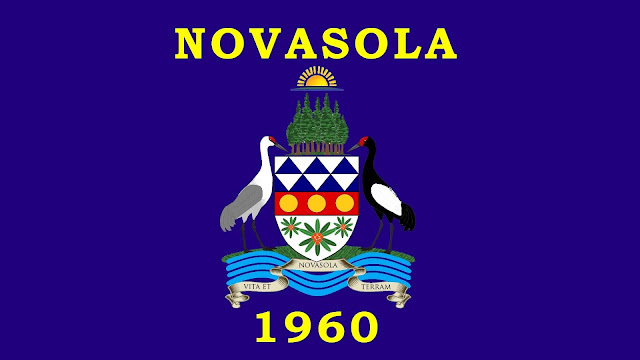Notes on Novasolan Flags, part 1
 |
| The official state flag of Novasola is one of many prelevant flags on poles across the island. |
Like the other US states, Novasola has a number of state
symbols. Their state bird, for example, is the Black Crane, Grus nigra, and
their state tree is the Novasola Madrone, Arbutus novasolensis. Its nickname is the
“Fastwater State”, and its motto is “Life and Land”. It even has a state
pattern. But no government symbols are perhaps more important and commonly seen
than flags, and in Novasola’s case flags give rise to most of those other
symbols. Novasola has a rich history of flag design and a wide array of state,
city, and tribal flags to explore.
Novasola Coat of Arms
The first official symbol of Novasola, the Novasola Coat of
Arms was adopted in 1780 after the founding of the Cape George colony by the
English as the Cape George Colony coat of arms, and later was applied to the entire territory and state. Although the term “coat of arms” refers in actuality only to the
escutcheon, or shield, in the center and the entire design is called a heraldic
achievement, the entire image is defined under Novasola state law as the
Novasola Coat of Arms. A modified version of the symbol encircled by the words “Great
Seal of the State of Novasola” serves as the state’s official seal. The design’s
trifurcated coat of arms in the center was created by combining visual
metaphors for England’s hopes for the colony. The white and blue portion at the
top is a pattern unique to Novasolan symbology and was likely meant to evoke
the island’s mountain ranges or rough seas, but unfortunately no records
survive which explain the pattern. Nevertheless, the alternating diamond
pattern, called an alterquin, is still heavily associated with Novasola today.
The middle portion features three annulets, or circles, of gold surrounded by
scarlet. These annulets represent an abundance of wealth and gold, which England
was hoping to find in the territory. The bottom third features the leaves and
fruit of the Novasola Madrone, which was common around Cape George and has
since always been associated with Novasola, and later became the state tree.
The shield is flanked by two supporters, each one of the two native species of
crane. The black crane later became the state bird. Above the shield in place
of a helmet is a stand of trees, evoking the island’s dense forests of
Coopers-firs, Island Redwoods, and other economically important tree species.
Logging remains one of Novasola’s largest industries. Atop the design is a
setting sun, representing the island’s western location and role in the British
Empire. Below the shield is the motto “Vita et Terram” which translates from
Latin to “Life and Land”, and the motto floats above a raging river design
which nods to the island’s many rivers and steep rapids.
Still in use, the Novasola Coat of Arms is the first and
longest continuously used symbol for the island, first as an English territory
and now as a US state. Many other state symbols, including the modern flag,
state bird, state tree, state pattern, and motto originate from this design.
Novasolan Red Ensign
This flag was used as a civil ensign for Novasola from 1795 to 1846 while the island was under British control and remained an unofficial flag for the territory until 1960. The design is a British Red Ensign with the Novasolan coat of arms. It is similar in both appearance and function to the Canadian Red Ensign. The purpose of the flag was mainly to distinguish Novasolan civilian and merchant ships from other territories while at sea and in port, but soon was seen flying over Novasolan government and civil buildings. Many members of early Novasolan provincial government promoted the flag as a way of building a distinct Novasolan identity.
First State Flag
In 1960 Novasola voted to become the fifty-first state in
the US. To mark the occasion and shift, a new flag was adopted to be used as
the official state flag. Like many US state flags, the design featured the
state’s seal, or in this case the coat of arms, atop a navy-blue backdrop along
with the words “Novasola” and “1960”. Many people, perhaps rightfully, disliked
the design and thought it lacked creativity or identity, yet the flag persisted
until 1995.
Current Flag
In 1995, after much lobbying and public support, state
congress passed a referendum which mandated a new state flag be adopted. A
committee was formed and accepted public submissions for a new design. After
narrowing the field, the committee allowed the general public to vote for a new
design out of a list of ten. This design won in a landslide victory and was
officially adopted later that year. Though submitted anonymously, a widely
accepted theory states the design was submitted by an elementary school art teacher
from Artemis.
The design features many of the same elements as the state coat
of arms, albeit simplified. The main body of the flag is red with a gold circle,
like the middle portion of the coat of arms, while the trailing edge features a
blue and white Novasolan alterquin pattern, like the upper portion of the coat
of arms. According to the state flag code, the gold circle represents Novasola’s
wealth and abundance of natural resources, standing alone in a sea of red like
an island, as well as joy and hope for a bright future. The blue represents the
pacific and the flowing rivers which give Novasola the nickname “The Fastwaters”,
and the unity of Novasolan people. The white represents the mountains,
glaciers, and fog which bring grandeur and majesty to Novasola, as well as the independent
spirit of Novasolan citizens, from the first settlers onward. The flag code
states red is used to evoke the bravery and passion which flows through the
blood of all Novasolan inhabitants, but more than likely red is used to further
evoke the coat of arms and the red ensign flag which many people would already
be familiar with.
The State Flag of Novasola, though young, was immediately welcomed
and embraced by Novasolans and often ranks highly in unofficial polls as one of
the most beloved state flags. Its image can be found on anything from clothing,
stickers, murals, logos, commercial products, etc. and a similar design is used
for state license plates. Its unique design seems to exude Novasolan pride and
to many captures the essence of the Fastwater State.
Along with the official state flag and coat of arms, each
of Novasola’s five major cities has adopted an official flag.
Flag of the city of Culver
Spurred on by the success of the statewide flag redesign in 1995, the city of Culver followed suit with its own flag redesign later that year. By the end of 1995, the state of Novasola, three of its major cities, firstly Culver, and one tribal government would officially adopt new flag designs. The new Culver flag features a blue Feasting Pigeon flying past, and blocking out, the sun. The city was named for the bird, as enormous flocks of pigeons frequented the area when it as founded, and the city had already been using the Feasting Pigeon as a local mascot for years before the redesign.
Flag of the city of Artemis
Artemis adopted a new flag design in 1995 as well. The old
design featured the city seal in yellow atop a white background. The city’s
official seal features an image of the Greek goddess Artemis firing her bow
into the night sky, surrounded by animals and mountains. The new design took
one feature from the seal, Artemis’ bow, and places it over a gold backdrop
next to two bars, one of navy and one white. The Blue bar is meant to represent
Fairweather Sound, as well as order and justice. The white bar represents the
Paramounts, especially the Arrowhead Mountains, which border Artemis to the
west and are home to the area’s many mines. The gold represents the many
precious metals and ore mining which brought the city most of its wealth, as
well as prosperity in general. The bow evokes the seal and may represent the
abundant game in the area or strength and the spirit of tenacity.
Flag of the city of Twin Rivers
Again adopted in 1995, the flag of the city of Twin Rivers
features a green bar beside five white and blue stripes. The green symbolizes nature,
agriculture, and the fertile lands which provides for the city, while the two
blue stripes represent the twin rivers themselves, the Pollux and Castor, which
flow in parallel through the Twin River Basin, between which lies the city.
Flag of Cape George
The official flag for the city of Cape George was originally
designed in 1854, and adopted a few years later. Before this, the city had no
official flag and usually flew either the red ensign or the coat of arms
outside public buildings. This design features an English cross sandwiched
between two blue bars, which evokes the city’s origin as an English colony and
the city’s location on a long, narrow arm of land jutting into the sea,
bordered on either side by the waters of Charlotte Sound and Georgian Bay.
Flag of Vodograd
The oldest city on Novasola, it is fitting that Vodograd would also have the oldest city flag. Originally designed in 1773, the flag features a tree and star over a white backdrop with blue and red bars on the trailing edge. The tree represents the dense rainforests surrounding the city and the city’s major export, timber. The star, located in the northwest corner of the flag, represents the city itself and its location on the island. Its four points resemble a compass or the cardinal directions, which brings to mind the city’s founding as part of a Russian naval exploration and expansion. The blue stripe represents the Chidkayook river, upon which the city rests and is dependent, and the red stripe the salmon so crucial to the city’s fishing industry. Together, the white, blue, and red stripes evoke the Russian flag, as Vodograd was originally a Russian colony.
 |
| Museum of Novasola |








